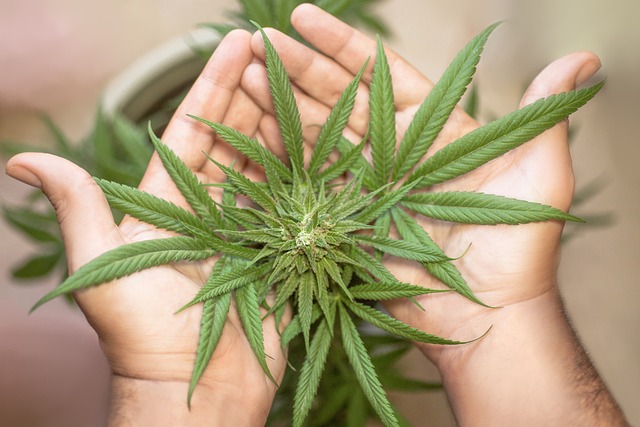The THCA flower, rich in non-psychoactive THCA compounds, has emerged as a potential therapeutic agent, particularly for its anti-nausea properties. Studies have demonstrated its efficacy in alleviating symptoms of nausea and stimulating appetite, making it a promising alternative to traditional antiemetics, especially for individuals undergoing treatments like chemotherapy. The therapeutic effects of THCA flower arise from its interaction with the endocannabinoid system, where compounds within it bind to cannabinoid receptors to regulate responses to nausea and vomiting. The presence of additional cannabinoids such as CBD in the THCA flower may enhance these benefits, suggesting a synergistic effect that could offer broader health advantages. Research continues to explore the full potential of these phytochemicals to maximize the therapeutic uses of THCA flower, particularly its anti-nausea properties.
Explore the transformative potential of THCA flower, a natural wellness powerhouse, within the comprehensive guide that follows. This article delves into the intricate chemistry and therapeutic properties of tetrahydrocannabinolic acid (THCA), the non-psychoactive precursor to THC. We’ll examine its role in alleviating nausea, the optimal cultivation and processing methods for preserving its anti-nausea compounds, and how it interacts with other cannabinoids to amplify benefits through the entourage effect. Join us as we navigate through clinical studies, legal considerations, and personal experiences to uncover the myriad ways THCA flower can be a valuable addition to your health regimen.
- Unveiling THCA Flower and Its Role in Natural Wellness
- The Chemical Composition of THCA: A Closer Look
Unveiling THCA Flower and Its Role in Natural Wellness

THCA flower, or tetrahydrocannabinolic acid flower, is a naturally occurring compound found in the Cannabis sativa plant that has garnered attention for its potential therapeutic benefits. Unlike its well-known counterpart, delta-9-tetrahydrocannabinol (THC), THCA exists in its non-psychoactive acid form and interacts with the body’s endocannabinoid system. This interaction is believed to contribute to a range of wellness effects, including anti-nausea properties. Studies suggest that THCA flower may be effective in alleviating nausea and stimulating appetite without the psychoactive effects associated with THC. Its potential as a natural remedy for nausea is particularly promising for individuals undergoing treatments like chemotherapy where traditional antiemetics might not suffice. The anti-nausea compounds found in THCA flower work by binding to cannabinoid receptors in the body, which can help regulate nausea and vomiting sensations, making it a valuable option for those seeking alternative solutions for managing gastrointestinal distress. As research continues to unfold, the role of THCA flower in promoting natural wellness through its anti-nausea properties becomes increasingly clear, offering hope for those looking for safe and effective ways to complement their wellness regimen.
The Chemical Composition of THCA: A Closer Look

Delta-9-tetrahydrocannabinolic acid (THCA) is a naturally occurring compound found in the cannabis plant, which, when heated or exposed to certain light sources, converts into the well-known psychoactive substance THC. The THCA flower, rich in this non-psychoactive precursor, has garnered attention for its potential therapeutic properties, particularly in the realm of anti-nausea compounds. Research indicates that THCA interacts with the body’s endocannabinoid system, influencing various physiological processes without the psychoactive effects associated with THC. This interaction may contribute to its efficacy as an anti-emetic agent, making it a subject of interest for individuals seeking relief from nausea and vomiting, often related to chemotherapy or other medical conditions.
The chemical composition of THCA is complex, with a variety of cannabinoids, terpenes, flavonoids, and other phytochemicals coexisting within the flower. Among these, cannabidiol (CBD) and other related compounds are also present in significant amounts, which further enhance the potential therapeutic benefits. The synergy between these compounds is believed to play a crucial role in modulating the effects of THCA, potentially offering broader applications for health and well-being beyond just anti-nausea properties. As scientific research continues to evolve, the understanding of how these chemical components interact within the flower is becoming more nuanced, leading to a more informed approach to harnessing its full potential for therapeutic use.
THCA flower, a precursor to the well-known THC, emerges as a significant player in the realm of natural wellness. Its chemical composition, rich in unique cannabinoids and terpenes, offers promising anti-nausea properties that could benefit those experiencing symptoms related to various conditions. As research continues to unfold the therapeutic potential of this botanical compound, it becomes increasingly clear that THCA flower holds a valuable place in the holistic health toolkit. Its potential extends beyond anti-nausea benefits, offering a wide array of wellness applications. This article has shed light on the intricate makeup of THCA and its natural role within the cannabis plant, paving the way for further scientific exploration and innovation in the field of natural remedies.
